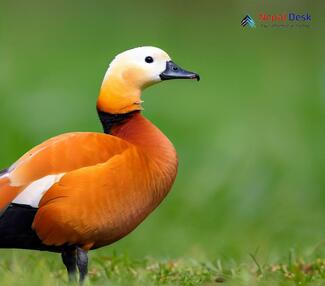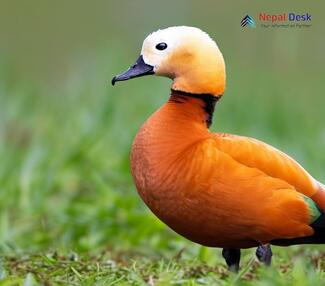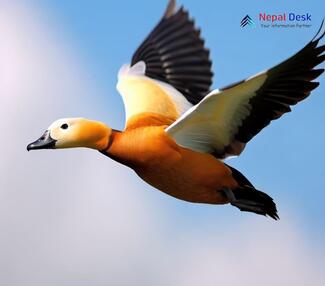Against the backdrop of Nepal's towering peaks, a flash of orange cuts through the thin mountain air. The Ruddy Shelduck (Tadorna ferruginea), known locally as Chakhewa, embodies the remarkable resilience of high-altitude waterfowl. This extraordinary bird, with its distinctive rusty-orange plumage and remarkable migratory capabilities, serves as a living bridge between the frigid Mongolian steppes and the temperate wetlands of South Asia.
Nature's High-Altitude Specialist
The Ruddy Shelduck stands apart from typical waterfowl through its remarkable adaptations to extreme environments. Its striking appearance features a warm rusty-orange body contrasting sharply with pale head feathers and distinctive black wingtips. During the breeding season, male birds develop a subtle yet elegant black neck ring, a feature that exemplifies the species' sexual dimorphism. Their large wingspan, typically ranging from 121 to 145 centimeters, enables efficient gliding during their extraordinary high-altitude migrations.
Recent research from the Max Planck Institute for Ornithology has unveiled the physiological marvels that enable these birds to thrive in oxygen-depleted environments. Their enhanced hemoglobin efficiency surpasses that of most vertebrates, allowing them to extract maximum oxygen from the thin air at altitudes exceeding 5,000 meters. This adaptation, combined with specialized mitochondrial functions and increased capillary density in flight muscles, creates a biological system perfectly tuned for high-altitude performance.
Masters of Trans-Himalayan Migration
The migratory journey of the Ruddy Shelduck represents one of nature's most impressive feats of navigation and endurance. These birds undertake biannual migrations spanning over 1,600 kilometers, crossing the world's highest mountain range with remarkable precision. Unlike many migratory species that follow valleys or lower elevation routes, Ruddy Shelducks often fly directly over the highest peaks, maintaining sustained flight at altitudes that rival commercial aircraft.
Their navigation system combines multiple sophisticated mechanisms. Recent studies using GPS tracking have revealed that these birds utilize a combination of celestial cues, geomagnetic sensing, and visual landmarks to maintain their course. This multi-modal navigation system enables them to return to the same wetlands year after year, often arriving within days of their previous year's schedule.
Nepal: A Critical Haven
Nepal's diverse landscape plays a crucial role in the survival of Ruddy Shelduck populations. The country's network of high-altitude lakes and wetlands provides essential stopover sites during their arduous migrations. Rara Lake, situated at 2,990 meters above sea level, serves as a premier destination for these birds, offering a unique combination of abundant food resources and minimal human disturbance.
The Koshi Tappu Wildlife Reserve, designated as a Ramsar site of international importance, represents another vital habitat. Recent surveys conducted by the Department of National Parks and Wildlife Conservation have documented increasing winter populations, with over 2,000 individuals recorded during peak season. This success story demonstrates the effectiveness of Nepal's conservation initiatives.
Ecological Relationships and Behavior
The Ruddy Shelduck exhibits fascinating behavioral adaptations that set it apart from other waterfowl species. Unlike most ducks that nest in ground vegetation, these birds frequently utilize abandoned burrows, cliff faces, and tree cavities for nesting. This unusual nesting behavior, combined with their strong monogamous pair bonds, reflects their evolutionary adaptation to harsh mountain environments.
Their dietary flexibility contributes significantly to their success across diverse habitats. Through careful observation, researchers have documented these birds consuming everything from aquatic invertebrates to terrestrial plant matter. This omnivorous diet enables them to thrive in various wetland ecosystems, from high-altitude lakes to lowland marshes.
Cultural Heritage and Conservation
In Nepalese culture, the Ruddy Shelduck holds a special place as both a spiritual symbol and an ecological indicator. Known as Chakhewa in Nepali, these birds feature prominently in local folklore, often regarded as messengers between the earthly and spiritual realms. This cultural significance has helped foster community-based conservation efforts throughout their range.
The conservation challenges facing Ruddy Shelducks mirror broader environmental concerns. Climate change threatens to alter the timing and availability of their traditional stopover sites, while habitat degradation from urban development and agricultural expansion continues to reduce suitable wetland areas. However, Nepal's commitment to wetland conservation, exemplified by the protection of sites like Ghodaghodi Lake under the Ramsar Convention, provides hope for the species' future.
Citizen Science and Future Prospects
The rise of citizen science initiatives has revolutionized our understanding of Ruddy Shelduck movements and behavior. Through platforms like eBird and the Asian Waterbird Census, researchers and enthusiasts collaborate to track population trends and identify critical habitat areas. These efforts have revealed previously unknown stopover sites and helped refine conservation strategies.
For visitors hoping to observe these remarkable birds, Nepal offers unparalleled opportunities. The best viewing period extends from October through March, with prime locations including the pristine waters of Rara Lake, the diverse wetlands of Koshi Tappu, and the biodiverse Ghodaghodi Lake complex. Responsible ecotourism not only provides economic incentives for conservation but also raises awareness about the importance of preserving these unique birds and their habitats.
A Symbol of Resilience
The Ruddy Shelduck exemplifies nature's capacity for adaptation and survival in extreme environments. As climate change threatens to reshape mountain ecosystems, these birds may serve as crucial indicators of environmental health and harbingers of change. Their continued presence in Nepal's skies depends on sustained conservation efforts and international cooperation to protect critical wetland habitats along their migration routes.
The story of the Ruddy Shelduck transcends mere biological interest—it represents the interconnectedness of landscapes, species, and human cultures across Asia. By protecting these remarkable birds and their habitats, we preserve not only a magnificent species but also the natural and cultural heritage of the Himalayan region for future generations.
Extraordinary Adaptations and Behaviors
Physiological Marvels of High-Altitude Flight
The Ruddy Shelduck's ability to fly at extreme altitudes represents one of nature's most remarkable engineering solutions. To understand their extraordinary capabilities, we must examine the multiple adaptations that work in concert to enable their high-altitude flights. These birds have evolved specialized respiratory and circulatory systems that would make them valuable subjects for aerospace medicine research.
Their blood contains a unique variant of hemoglobin that binds oxygen more efficiently than that of most other birds. Recent studies conducted at the University of British Columbia have shown that their hemoglobin maintains up to 94% oxygen saturation at altitudes where human hemoglobin would drop to dangerous levels below 70%. This exceptional oxygen-binding efficiency allows them to extract maximum benefit from each breath in the thin mountain air.
The birds' lung structure also shows remarkable specialization. Unlike the dead-end air sacs found in human lungs, Ruddy Shelducks possess a complex system of air sacs that enable continuous, one-way airflow through their respiratory system. This design, perfected over millions of years of evolution, achieves gas exchange efficiency that surpasses the most advanced artificial oxygen delivery systems. Their enhanced capillary network in flight muscles ensures rapid oxygen delivery exactly where it's needed most during sustained high-altitude flight.
Thermal Regulation and Environmental Adaptation
Surviving in environments ranging from freezing Himalayan lakes to warm lowland wetlands requires sophisticated temperature regulation mechanisms. The Ruddy Shelduck has developed an intricate system of counter-current heat exchange in its legs and feet. This system, similar to but more efficient than those found in other waterfowl, allows them to stand in near-freezing water while maintaining their core body temperature.
Their feather structure represents another triumph of natural engineering. Each feather contains microscopic interlocking barbules coated with specialized oils produced by their preen gland. Recent analysis using electron microscopy has revealed that these barbules create a more effective waterproof barrier than synthetic materials used in high-end outdoor gear. This natural waterproofing system maintains its effectiveness across a remarkable temperature range, from near-freezing highland lakes to warm tropical wetlands.
Cognitive Abilities and Social Intelligence
Beyond their physical adaptations, Ruddy Shelducks display remarkable cognitive abilities that challenge our understanding of avian intelligence. Their navigation skills involve processing multiple streams of sensory information simultaneously, including magnetic field detection, celestial navigation, and visual landmark recognition. This multi-modal navigation system enables them to return to specific wetlands with extraordinary precision, often arriving at the same location within days of their previous year's schedule.
Their social behavior reveals another dimension of their intelligence. Unlike many waterfowl species that form large, loose flocks, Ruddy Shelducks maintain strong pair bonds that can last for multiple breeding seasons. These partnerships involve complex coordination during migration, with pairs maintaining contact through specific vocalizations that can be distinguished even in noisy flocks. Research conducted at wetland sites in Nepal has documented up to 15 distinct call types, each serving specific communication functions.
Breeding Strategies and Reproductive Adaptations
The breeding behavior of Ruddy Shelducks represents a fascinating departure from typical waterfowl patterns. Their preference for elevated nesting sites, including cliff faces and tree cavities, requires specialized physical adaptations and behavioral strategies. The ducklings, unlike those of most waterfowl species, must be capable of surviving a considerable drop from the nest to the water or ground below immediately after hatching.
Their reproductive timing shows remarkable synchronization with environmental conditions. Studies conducted across their range have shown that breeding pairs can adjust their nesting schedule based on subtle environmental cues, including day length, temperature patterns, and food availability. This flexibility becomes increasingly crucial as climate change alters traditional seasonal patterns in their breeding grounds.
Feeding Ecology and Resource Utilization
The feeding strategies of Ruddy Shelducks demonstrate impressive adaptability across diverse habitats. Their bill morphology allows them to process both animal and plant matter efficiently, making them true omnivores. In highland environments, they show a preference for aquatic invertebrates and specialized high-altitude plants, while in lowland areas, they readily switch to agricultural grains and wetland vegetation.
Recent studies using stable isotope analysis of feathers have revealed that these birds adjust their diet seasonally, maximizing energy intake based on available resources. This dietary flexibility plays a crucial role in their ability to accumulate sufficient fat reserves for long-distance migration while maintaining the protein intake necessary for feather maintenance and muscle repair.
Future Research Directions
Understanding Ruddy Shelduck's remarkable adaptations opens new avenues for scientific research across multiple disciplines. Their high-altitude physiology could inform developments in aerospace medicine and high-altitude survival equipment. Their navigation abilities might provide insights for improving global positioning systems, while their thermal regulation mechanisms could inspire new approaches to cold-weather gear design.
Environmental changes across their range present both challenges and opportunities for research. Monitoring their responses to shifting climate patterns could provide early warnings of ecosystem changes in sensitive mountain environments. Their ability to adapt to various habitats might also offer insights into species resilience in the face of environmental change.
As we continue to unravel the mysteries of these remarkable birds, each discovery underscores their importance as both an ecological indicator species and a model system for understanding extreme environment adaptation. Their story reminds us that nature's solutions to complex challenges often surpass our technological achievements, offering valuable lessons for human innovation and environmental conservation.
Conservation Challenges
Current Conservation Status and Challenges
The conservation of Ruddy Shelducks presents unique challenges due to their extensive range and complex habitat requirements. While the species is not currently considered globally threatened, local populations face significant pressures from habitat modification, climate change, and human disturbance. Understanding these challenges requires examining multiple factors that affect their survival across different parts of their range.
Climate change poses perhaps the most significant long-term threat to Ruddy Shelduck populations. Rising temperatures affect high-altitude wetlands, altering water levels and vegetation patterns in critical breeding areas. Research conducted by the International Wetland Research Institute indicates that some traditional breeding sites in the Tibetan Plateau have experienced significant changes in water chemistry and vegetation composition over the past two decades, potentially affecting food availability and breeding success.
Nepal's Role in Species Conservation
Nepal's position along the Central Asian Flyway makes it crucial for Ruddy Shelduck conservation. The country's network of protected areas, particularly those in high-altitude regions, provides essential stopover sites during migration. Recent initiatives by the Department of National Parks and Wildlife Conservation have focused on expanding protection for key wetland habitats, resulting in a 25% increase in wintering populations at monitored sites over the past five years.
Community-based conservation programs in Nepal have proven particularly effective. Local initiatives around sites like Rara Lake and Koshi Tappu have successfully integrated traditional ecological knowledge with modern conservation practices. These programs employ residents as wetland guardians, combining habitat protection with sustainable ecotourism development. The success of these programs provides a model for other range countries seeking to balance conservation with community development.
Innovative Research and Monitoring Approaches
Modern technology has revolutionized our ability to study and protect Ruddy Shelducks. Satellite tracking studies initiated by international research consortiums have revealed previously unknown migration routes and stopover sites. These studies have also highlighted the species' remarkable ability to adjust their migration patterns in response to changing environmental conditions, suggesting some capacity for adaptation to climate change.
Genetic research has provided new insights into population structure and connectivity. DNA analysis of feathers collected from different breeding populations has revealed distinct genetic lineages, emphasizing the importance of protecting multiple breeding sites to maintain genetic diversity. This research also suggests that some populations may be more vulnerable to environmental changes than others, helping to prioritize conservation efforts.
Economic Value and Ecosystem Services
The presence of Ruddy Shelducks generates significant economic benefits through ecotourism. In Nepal alone, birdwatching tourism focused on this and other high-altitude species contributes an estimated $3.2 million annually to local economies. This economic impact helps justify conservation expenditures and provides tangible benefits to communities involved in protection efforts.
Beyond their tourism value, these birds provide important ecosystem services. Their feeding activities help maintain wetland plant diversity, while their movements facilitate seed dispersal between isolated water bodies. Recent research has also shown that their presence can indicate the health of high-altitude wetland ecosystems, making them valuable indicator species for environmental monitoring programs.
Future Conservation Strategies
Successful long-term conservation of Ruddy Shelducks requires a multi-faceted approach that addresses both immediate threats and long-term challenges. Key components of future conservation strategies should include:
Protection of critical habitats across their entire range, with special attention to breeding sites and stopover locations. This requires international cooperation and standardized monitoring protocols to track population trends and habitat changes effectively.
Development of climate change adaptation strategies that consider potential shifts in migration patterns and habitat use. This might include identifying and protecting potential future habitat areas and maintaining connectivity between different parts of their range.
Expansion of community-based conservation programs that have proven successful in Nepal to other range countries. These programs should emphasize local stakeholder involvement and sustainable economic benefits from conservation activities.
Educational Initiatives and Public Engagement
Raising public awareness about Ruddy Shelducks and their conservation needs remains crucial. Educational programs in Nepal have successfully engaged local communities in conservation efforts by highlighting the species' cultural significance and economic value. Similar programs could be implemented across their range, adapted to local cultural contexts and conservation priorities.
Citizen science initiatives have shown particular promise in monitoring Ruddy Shelduck populations. Programs like eBird and the Asian Waterbird Census enable amateur birdwatchers to contribute valuable data about species distribution and abundance. These programs also help build public support for conservation efforts by engaging people directly in scientific research.
Looking Ahead: A Model for High-Altitude Conservation
The story of Ruddy Shelduck conservation provides valuable lessons for protecting other high-altitude species. Their ability to adapt to changing conditions while maintaining traditional migration patterns offers hope for species facing similar challenges. However, their conservation also highlights the complexity of protecting migratory species in an era of rapid environmental change.
As we look to the future, the fate of the Ruddy Shelduck will likely serve as an indicator of our success in addressing broader conservation challenges. Their continued presence in the skies above the Himalayas will depend on our ability to maintain critical habitats, address climate change impacts, and foster international cooperation in conservation efforts. The species stands as a testament to nature's resilience and adaptability, while also reminding us of our responsibility to protect the remarkable diversity of life that shares our planet.




